Last updated: April 26, 2025
Article
Alexander Hamilton
1755: Hamilton was born on the island of Nevis, in the Eastern Caribbean. His parents, Rachel Faucette and James Hamilton, were not married to each other; therefore there was no official record of his birth.
1765: Hamilton’s mother moved her two children, Alexander and James Hamilton, to St. Croix.
1768: Rachel Faucette died, leaving her two Hamilton sons penniless. They were placed in the care of her cousin, Peter Lytton.
1769: Peter Lytton died. Alexander Hamilton went to work for the trading company of Beekman and Cruger, which also had an office in New York City.
1773: Largely self-educated up to this point, Hamilton was offered an opportunity to come to America. He entered King’s College, now known as Columbia University and soon became active in the movement toward revolution.
1774: Hamilton organized an artillery company.
1776: At the battle of Harlem Heights Hamilton met General Washington for the first time.
1777: Hamilton joined Washington’s staff as aide de camp.
1780: Hamilton married Elizabeth Schuyler, daughter of Major General Phillip Schuyler.
1781: Hamilton distinguished himself during the siege of Yorktown.
1787: While working as an attorney, Hamilton continued to advocate a strong national government. He was a delegate to the Constitutional Convention, and the only original signer of the Constitution from New York, although others added their names later.
1788: Hamilton, James Madison and John Jay wrote the “Federalist Papers” in support of the Constitution.
1789: Hamilton became the first Secretary of the Treasury during President Washington’s administration. As Secretary, he organized the National Bank, the first U. S. monetary system, the tax system, the Customs Service, and established the national debt. In addition, he remained a trusted advisor to Washington on foreign policy, wrote the President’s speeches, etc.
1795: Hamilton resigned from the government and resumed his legal practice in New York.
1801: Hamilton’s eldest son, Phillip, was killed in a duel defending his father’s reputation.
1802: The Hamiltons moved into the Grange with their seven surviving children.
1804: Hamilton was killed in a duel with Vice President Aaron Burr.
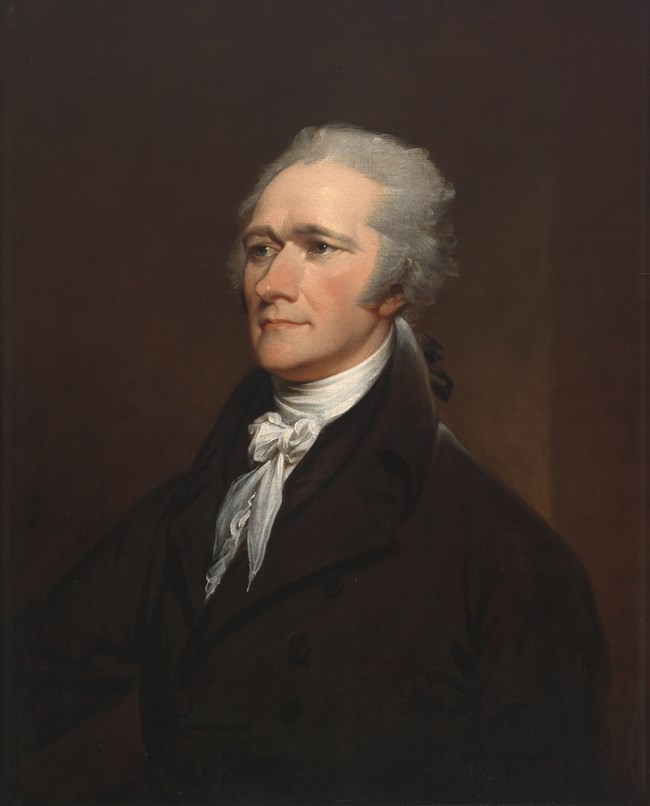
1806 John Trumbull. National Portrait Gallery.
Formative Years
Alexander Hamilton (c.1755-1804) was a Founding Father of the United States, soldier, lawyer, scholar, economist, congressman, and first U.S. Secretary of the Treasury. Born and raised in the West Indies, he was orphaned in his early teens. In his youth, he worked as a clerk for an international shipping company located on the island of St. Croix. His intelligence, writing, and administrative abilities were recognized by local benefactors who created a fund to provide him with a formal education in the North American colonies.
In 1772, Hamilton arrived in New York City. He began preparing for college at Eizabethtown Academy in New Jersey. He later studied at King's College (now Columbia University). During this period, he was involved in the political issues of his time. As a student, he wrote defenses of the revolutionary cause and published in local newspapers. He was determined to graduate in two or three years and raced through the curriculum, which included anatomy, Greek and Latin literature, rhetoric, geography, history, philosophy, math, and science. But he never completed his course of studies and left school to fight in the American Revolutionary War.
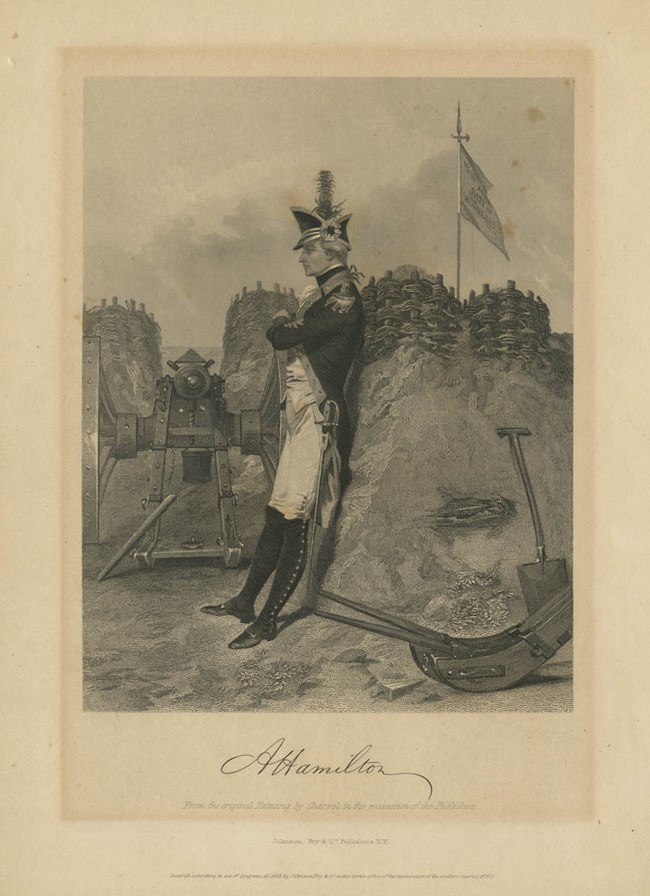
A Hamilton, 1858, NPS Photo.
Military Service
At the outbreak of the war, Hamilton joined other students in a volunteer militia regiment called the Corsicans. This regiment was later named the Hearts of Oak. Hamilton showed great potential as a leader through hardwork and study. In 1776, he accepted the rank of captain of the New York Provincial Company of Artillery. This company is still in existence as the 1st Battalion, 5th Field Artillery Regiment. It is one the oldest Regular Army units on active duty.
In 1777, Hamilton was invited to join General George Washington’s staff as an aide-de-camp with the rank of lieutenant colonel. The two men had a complementary relationship. Washington showed wise judgement, iron character, and immense self-control. Hamilton was brilliant, tireless, an able administrator, and a fast, skillful writer. Hamilton understood Washington intuitively, and Washington trusted him. This relationship developed throughout the war and early republic until Washington's death in 1799.
Hamilton served in numerous battles and played a role in iconic events. He crossed the cold waters of the Delaware River to surprise attack Hessian forces at Trenton, New Jersey. At Valley Forge, he and other aides wrote letters to governors and Congress asking for supplies. He also assisted in translating Friedrich von Steuben’s French infantry training manual to English. At the Siege of Yorktown, he bravely led Continental forces to capture a British redoubt. Throughout this time, shortages of clothing, shoes, horses, meat, flour, and gunpowder plagued the Continental army. The 13 delegations to the Continental Congress bickered among themselves, and their incompetence and pettiness in supplying the army infuriated Hamilton. By war’s end, he believed the country needed a central government with power over the states, a strong executive, and a national army.
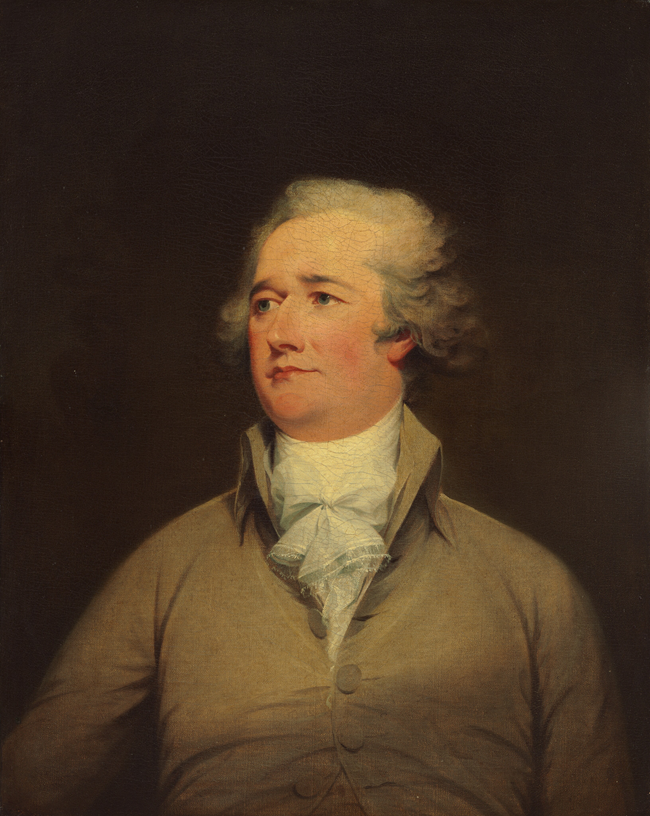
Alexander Hamilton, c.1792, John Trumbull, National Gallery of Art.
Post-War Accomplishments (1784-1795)
After his military service, Hamilton returned to New York where he passed the bar exam to practice law. Defending a British loyalist in 1784, he helped establish the principle that courts have the right and responsibility to interpret law. Judicial review remains a cornerstone of the American legal system today.
Hamilton also helped found the Bank of New York to reenergize the war-torn economy. In 1784, he helped to establish the Bank of New York. In 1781, the Bank of North America was the first bank established in the United States in Philadelphia, Pennsylvania. To assist New York commerce, Hamilton wrote the bank’s constitution. This document inspired other banks to follow a similar model.
In 1782, Hamilton was appointed to the Congress of the Confederation as a representative from New York and later served as an assemblyman in the New York State Legislator. In 1787, as a member of Congress, Hamilton attended the Constitutional Convention at Independence Hall in Philadelphia. Hamilton, James Madison, and John Jay later wrote a series of 85 essays known as the Federalist Papers. The essays were published in New York State newspapers and were written to persuade readers to support ratification of the U.S. Constitution. Writing 51 essays in total, Hamilton completed the bulk of the work.
As the first Secretary of the Treasury (1789-95), Hamilton devised plans for funding the national debt, securing federal credit, encouraging expansion of manufacturing, and organizing the federal bank. In 1790, in his Report on Public Credit, Hamilton urged that the federal government assume the Revolutionary War debts of the 13 states. Nevertheless, he needed support for his economic plan in Congress. At the time, Thomas Jefferson and others wanted the national capital further south. They struck a deal: Hamilton’s economic plan passed, and Washington, D.C. ultimately became the permanent capital. As an integral member of Washington's cabinet, Hamilton also developed the concept of "implied powers," which allowed the federal government to do things in support of the Constitution, that were not specifically spelled out in it. Hamilton made this argument to Washington when he sought to justify the chartering of a national bank.
From his time as a clerk in the West Indies, Hamilton realized the negative impact smugglers had on the economy. In 1790, Congress authorized the proposal of Secretary of the Treasury Hamilton to build ten cutters to enforce tariffs and protect the nation’s revenue. Later named the Revenue Cutter Service, this organization was the forerunner of the U.S. Coast Guard.
Hamilton also envisioned manufacturers playing a major role in the economy of the United States. At the request of Congress, he wrote the Report on Manufactures. In the report, he argued for the creation of subsidies and tariffs to promote industrial growth. He supported an organization called the Society for the Establishment of Useful Manufacturing (S.U.M). In supporting this organization, Hamilton planned to stimulate the nation’s economic system through mass manufacturing. This idea led to the growth of a little town in Passaic New Jersey into a hub for production of much needed goods.
In 1792, S.U.M purchased 700 acres of land surrounding Great Falls and established the city of Paterson, New Jersey (named after the New Jersey Governor William Paterson). The governor was a supporter of Hamilton's plans and he signed S.U.M.'s charter in November of 1791. While the early years had financial difficulties, Paterson is credited with being America’s first planned industrial city and birthplace of the Industrial Revolution in the United States.
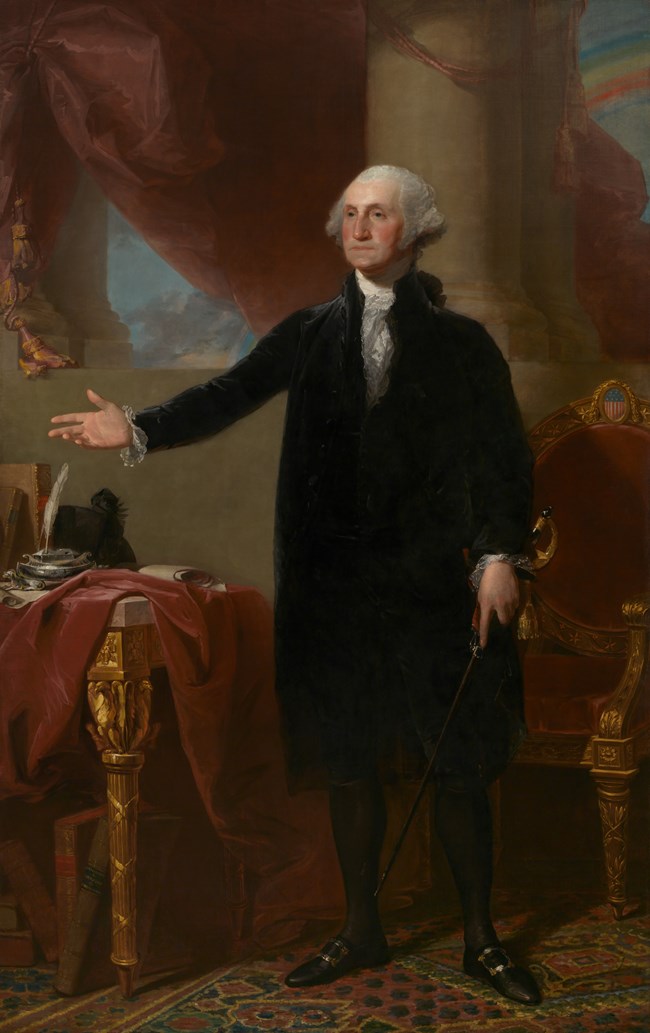
George Washington (Lansdowne Portrait), 1796, National Portrait Gallery.
The Quasi War with France (1798-1800)
Hamilton resigned from Washington's cabinet in 1795. Nevertheless, tensions rose between France and America during John Adams' presidential administration. These tensions were largely over French hostility toward American ships. Adams asked Washington to prepare and lead an army in case of war, but Washington was retired at the time. Indeed, he was hesitant to leave Mount Vernon until a war was declared. To prepare for a potential war, however, Washington supported making Hamilton a Major General and Inspector General of the United States Army. Adams (who didn’t care for Hamilton) reluctantly agreed and gave him the position. On December 14, 1799, George Washington died of a throat infection at Mount Vernon. Fortunately, Adams was able to avoid war through diplomatic initiatives. This concluded Hamilton’s service in the United States military.
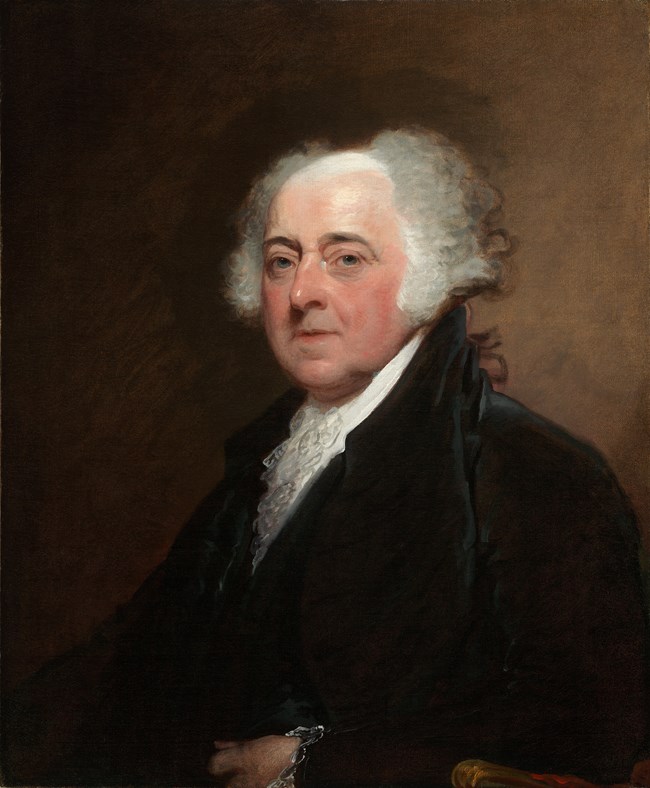
John Adams, c. 1800/1815, Gilbert Stuart, National Gallery of Art.
Feuding Federalists
In 1800, John Adams hoped for a second term as president. Nevertheless, Hamilton disliked Adams and challenged his character and his abilities in a report called "Concerning the Public Conduct and Character of John Adams, Esq. President of the United States". Both leaders were Federalists and the report hurt Hamilton’s standing in the party. Adams lost reelection to Thomas Jefferson, but most likely due to a combination of factors rather than simply the report. In 1801, Hamilton founded the New York Evening Post. In the wake of Jefferson’s election to the presidency, Hamilton sought to create a federalist newspaper. The newspaper is still in existence today. When Hamilton started living in The Grange in 1802, however, his political career was on a decline due to scandals, political infighting, and Jefferson's victory.
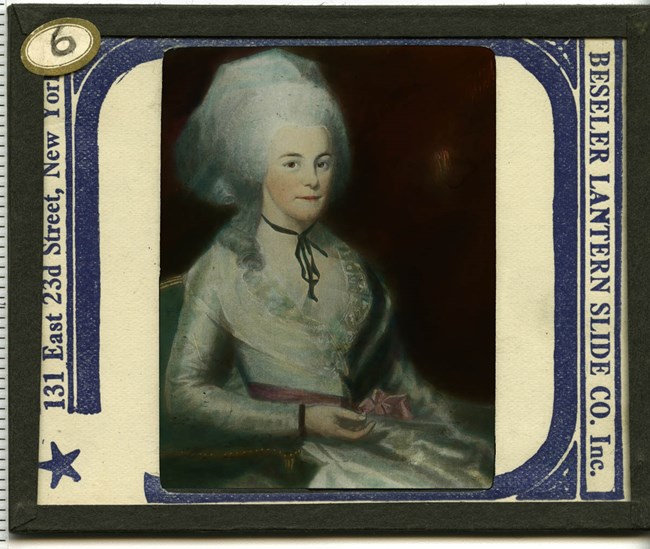
Elizabeth Schuyler Hamilton Portrait, Undated, NPS Photo.
Family
In 1768, Hamilton's mother, Rachel Faucette, passed away most likely due to Yellow Fever. His father, James Hamilton, abandoned him and his brother James when they were young. Nevertheless, Hamilton's later family life was much different than his early upbringing. In 1780, Alexander Hamilton and Elizabeth Schuyler were married at the Schuyler Mansion in Albany, NY. Elizabeth (also known as Eliza or Betsy) was from a prominent Dutch family. Her mother, Catherine, was a socialite who was born to the prominent Van Rensselaer family. Her father, Philip J. Schuyler, was a well-known general in the Continental Army and businessman. In fact, Hamilton and Eliza’s wedding was held in the parlor of Schuyler’s mansion. Alexander and Eliza were married for 24 years and had eight children together. Tragically, in 1801, the couple's eldest son Philip died in duel defending his father's honor. Hamilton and Eliza never recovered from the blow. "Never did I see a man," wrote one friend. "so completely overwhelmed with grief as Hamilton." Later in life, Hamilton’s children fondly remember their father singing with them, reading the bible out loud in the garden, and saying goodnight.
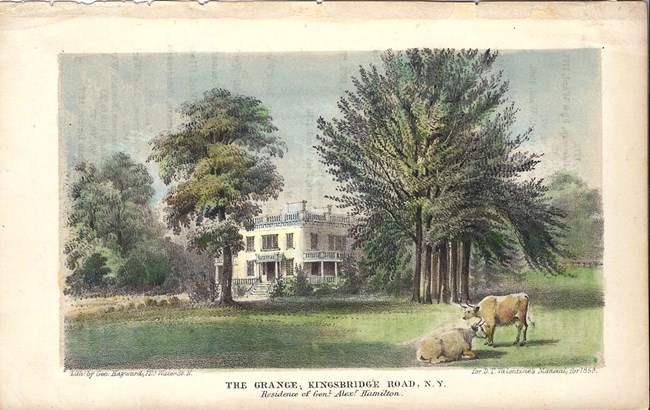
The Grange, Kingsbridge Road, N.Y. Residence of Genl. Alexr. Hamilton, c.1858, NPS Photo.
Building The Grange
Hamilton commissioned architect John McComb Jr. to design a Federal-style country home on a 32-acre estate in upper Manhattan. This house was completed in 1802 and named "The Grange" after his father's ancestral home in Scotland. The home was in a wooded area and was watered by two streams. The 200ft elevation offered Hamilton views of the Hudson River on the west and the Harlem and East Rivers on the east. Unfortunately, he was only able to enjoy his home for two years. On July 11, 1804, Hamilton was fatally wounded in a duel with his personal and political rival Vice President Aaron Burr. After Hamilton's death, his friends created a secret fund that enabled Eliza to keep The Grange. In 1833, however, Eliza sold the home and later moved to Washington D.C.
In the years that followed, the building had several owners and was physically moved twice to adapt to the demands of the changing city. The Grange has been used as a private residence, church, museum, and day school. On April 27, 1962, Public Law 87-438 authorized the establishment of Hamilton Grange National Memorial. The purpose of this was to "preserve and restore the former dwelling house of Alexander Hamilton (commonly known as The Grange) as a fitting memorial to Alexander Hamilton, interpreting this resource in a manner to instill in the visitor an awareness and an appreciation of the role this extraordinary and complex man played in the political and economic development of the United States." Today, visitors may experience historically furnished rooms, exhibits, special events, and much more!
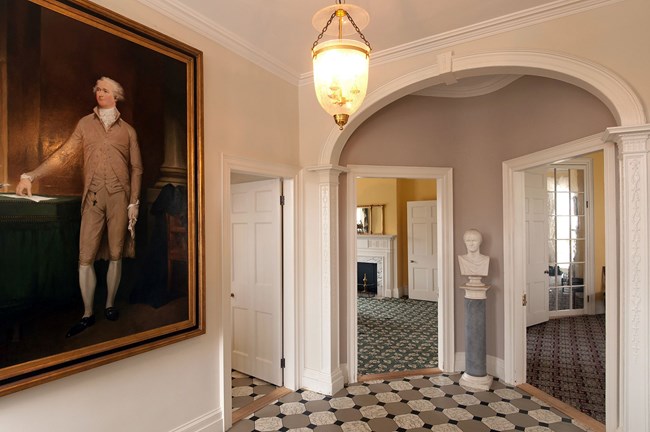
Entrance Hall, Undated, NPS Photo.
Legacy
Hamilton contributed greatly to the establishment of the United States and his influence is still felt across the world. As a writer of the bulk of the Federalist Papers, his words are still used by lawmakers to interpret the Constitution. In his role as Secretary of the Treasury, he set forth major economic policies and set a precedent by using the “implied powers” of the Constitution to create a national debt, public credit, and national bank. Furthermore, he protected trade by founding the Revenue Cutter Service (forerunner of the U.S. Coast Guard). These contributions and many other accomplishments have secured Hamilton’s status as a Founding Father. Like many historical figures throughout time, Hamilton’s legacy has been celebrated and overlooked depending on the circumstances of each generation. Currently, Hamilton is regarded as a cultural icon for his use in media. He continues to inspire, inform, and spark conversation about his life and times.
Tags
- christiansted national historic site
- colonial national historical park
- hamilton grange national memorial
- independence national historical park
- national parks of new york harbor
- paterson great falls national historical park
- saratoga national historical park
- yorktown battlefield part of colonial national historical park
- hamilton
- hamilton grange
- alexander hamilton
- revolutionary war
- west indies
- new york
